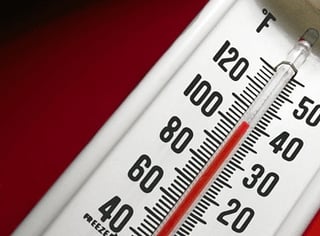Stay Cool and Avoid Heat Illness
Your job is already hazardous, but working in certain weather conditions can make it even more so. When it is hot outside, your body temperature can rise to unsafe levels. Normally, your body cools itself through sweating, but in hot and humid weather, sweating is not enough and the result can be a dangerous heat illness.

Staying Cool
Follow the suggestions below to stay cool when working in hot weather:
- Wear loose, light-colored clothing when possible, along with a hat.
- Gradually build up to heavier work and more strenuous tasks.
- Take breaks in a cooler area when possible, and remove any outer protective gear you’re wearing.
- Avoid overexerting yourself during peak temperature periods (midday).
- Drink liquids frequently, even if you don’t feel thirsty—at least 8 ounces every 20 to 30 minutes. Choose water, fruit juice or sports drinks and stay away from liquids containing caffeine, which can dehydrate you.
Recognizing the Symptoms
There are three forms of heat illness, each with its own distinct symptoms:
- Heat cramps – severe muscle spasms in the back, stomach, arms and legs which are attributed to the loss of body salt and water during periods of heavy perspiration
- Heat exhaustion – heavy sweating, cool or pale skin, nausea, headache, weakness, vomiting and fast pulse
- Heat stroke – high body temperature, sweating stops, red and often dry skin, rapid breathing and pulse, headache, nausea, vomiting, diarrhea, seizures, confusion or unconsciousness
Providing Treatment
It is essential to treat heat illness as soon as possible. If you are feeling any of the above symptoms, inform a co-worker and ask for help. If you suspect that a fellow worker has any of these conditions, follow the first-aid suggestions below:
- Heat cramps – Move the victim to a cooler area and allow him or her to drink approximately 6 ounces of water every 15 minutes. Follow up with a medical examination.
- Heat exhaustion – Move the victim to a cooler area and keep him or her lying down with legs slightly elevated. Cool the victim’s body by fanning and applying cool, wet towels. If conscious, allow the victim to drink approximately 6 ounces of water every 15 minutes. Follow up with a medical examination.
- Heat stroke – You or a bystander should immediately call an ambulance. Meanwhile, move the victim to a cooler area, remove his or her outer clothing, immerse him or her in cool water or apply cool, wet towels or cloths to the body. Do NOT give the victim liquids. If medical help is delayed, call the hospital for further instructions while waiting. Heat stroke is life-threatening, so it’s important to move quickly!
Safety Reminder
The risk of heat illness increases with age, poor diet, being overweight, insufficient liquid intake, poor physical condition and/or when taking medication. Never take salt tablets without your doctor’s approval.
Be aware of weather conditions when you will be working outside so that you can be prepared with appropriate clothing and beverages. If you are working outside and start to feel any adverse symptoms, inform your supervisor and take a break.
COMMENTS